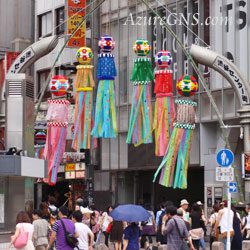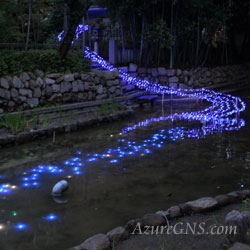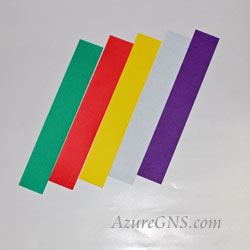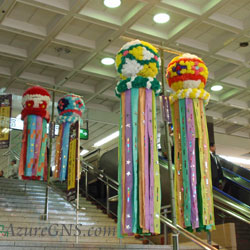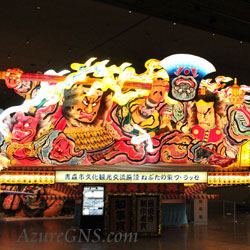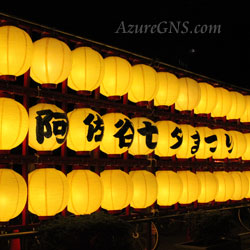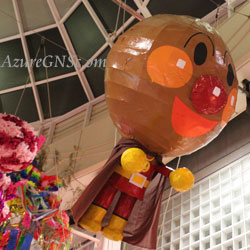(7月7日)
Tanabata;
The Star Festival
(July 7th)
●七夕 Tanabata; the Star Festival
●天の川 the Milky Way
●牽牛(けんぎゅう)(彦星) the Cowherd Star (Altair)
●織女(しょくじょ)(乙姫) the Weaver Star (Vega)
●願い事 wish
●色紙 colored paper
●短冊 tanzaku; a strip of colored paper; a rectangular-shaped card for writing poetry
●竹 bamboo
●竹飾り take-kazari; Tanabata Bamboo decoration
●笹 a bamboo grass
●笹の葉 a bamboo leaf; a bamboo blade
●お供え物 an offering
◆一般的に星祭り、七夕は7月7日に行われ、地方によっては旧暦に従って、8月8日に行われます。
Tanabata, the Star Festival, usually falls on July 7th and in some regions is celebrated on August 8th following the lunar calendar.
◆中国には彦星(牽牛)と織姫(織女)についての伝説があります。
In China, there is a legend about Hiko-boshi (the Cowherd Star, Altair) and Ori-hime (the Weaver Star, Vega).
◆彦星と織姫はとても愛し合っていましたが、神様はそれを許しませんでした。
Hiko-boshi and Ori-hime loved each other very much, but the gods forbade their love.
◆神様は二人を引き離し、年に一度だけ、7月7日の夜に天の川で会うことを許しました。
The gods separated them and only allowed them to meet in the Milky Way once a year on the night of July 7th.
◆この伝説が星祭りとして、日本に伝わりました。
This legend was introduced to Japan as the Star Festival.
◆日本の地方の習慣やお盆の準備と結び付き、七夕になりました。
It was combined with local customs in Japan and preparations for O-bon (the Bon holiday) ― thus becoming Tanabata.
◆緑、赤、黄、白、黒(または紫)の5色の短冊に願い事を書きます。
People write their wishes on tanzaku (strips of paper of five different colors): green, red, yellow, white and black (or purple).
◆これらの5色は陰陽五行思想から生まれ、緑は木、赤は火、黄は土、白は金、黒(または紫)は水を表します。
These five colors derive from the Yin-Yang and the Five Elements Theory with green representing trees, red representing fire, yellow representing soil, white representing metal and black (or purple) representing water.
◆牽牛と織女の伝説にちなみ「好きな人と結ばれますように」と願う若者もいます。
Following the legend of the Cowherd Star and the Weaver Star, some young people make a wish such as “I wish I could be with someone I like.”
◆七夕の夜に、お習字や縫物の上達を星に願うと叶うと言われています。
It is said that people’s wishes for improvement in their calligraphy or sewing will be realized if they pray to the stars on Tanabata night.
◆色紙でいろいろな飾りも作ります。
They also make various ornaments with pieces of paper.
◆短冊と飾りを笹の枝に結び竹飾りを作ります。
Tanzaku and ornaments are tied to bamboo branches to make Tanabata bamboo decorations.
◆笹飾り用の竹は、七夕が近付くと花屋さんやホームセンターで購入することができます。
When Tanabata is drawing near, fresh bamboo for take-kazari is sold at flower shops or DIY stores.
◆安価で売られていますが、数日で枯れてしまうのが難点です。
They are not expensive but will wilt in several days.
◆短冊、色紙、七夕飾りと、プラスティックでできた竹の「七夕セット」も売られています。
We can also buy a “Tanabata kit” which consists of tanzaku, some Tanabata ornaments, and a stalk of plastic bamboo.
◆最近は竹や七夕セットをインターネットで取り寄せることもできます。
Nowadays, bamboo and the “Tanabata kit” are even sold through on-line Internet sites.
◆日本中の多くの神社やお寺では七夕の宗教行事が行われます。
The religious rites of Tanabata are held in shrines and temples throughout Japan.
◆子供達は七夕の歌を歌ったり、お菓子を食べたりして楽しみます。
Children enjoy singing the Tanabata song and eating sweets and snacks.
◆多くの若い恋人達は浴衣(夏に着る木綿の単衣)を着て、ロマンチックな七夕の夜のデートを楽しみます。
Many young couples enjoy a romantic Tanabata evening date wearing yukata (simple cotton kimono, a Japanese traditional costume, for summer).
◆多くの商業施設でも集客のため、様々な七夕イベントが行われます。
Many businesses host various Tanabata events to attract customers.
◆宮城県仙台市の七夕まつりは日本で一番有名な七夕まつりです。
Tanabata in Sendai City, Miyagi Prefecture has the largest and most famous celebration.
◆神奈川県の湘南平塚七夕まつり、愛知県の安城七夕まつりと並んで、日本三大七夕祭りの1つに数えられます。
This Tanabata is counted among the three major Tanabata in Japan along with the Shonan-Hiratsuka Tanabata Festival in Kanagawa Prefecture and the Anjyo Tanabata Festival in Aichi Prefecture.
◆仙台七夕まつりは青森ねぶた祭、秋田竿灯まつりと共に、東北三大祭りの1つです。
The Sendai Tanabata Festival is one of the three major festivals in the Tohoku Area along with the Aomori Nebuta Festival and the Akita Kanto Festival.
◆仙台七夕は江戸時代(1603-1867)初期に仙台藩初代藩主の伊達正宗が始めたと言われています。
It is said that Date Masamune, the first lord of the Sendai Domain, started Sendai Tanabata in the beginning of the Edo Period (1603-1867).
◆それ以来、戦争や不景気などで何度か中断しましたが、現在では毎年200万人以上の人が訪れる大規模な七夕祭りです。
Though it was interrupted several times due to wars or recession, it is now a large-scale festival with more than 2 million people visiting every year.
◆神奈川県平塚市は第二次世界大戦中、海軍火薬廠があったためアメリカ空軍の空爆に遭い、焼け野原になりました。
Since there was a Navy Ammunitions Arsenal in Hiratsuka City, Kanagawa Prefecture during World War ll, the city was totally burned down when bombs were dropped by American aircraft.
◆終戦後の1951年(昭和26年)に仙台七夕を模範に、平塚で初めて七夕まつりが開催されました。
After World War ll in 1951 (Showa 26th yr), the first Tanabata in Hiratsuka was held following Sendai Tanabata.
◆湘南平塚七夕まつりの吹き流しには電飾がほどこされています。
Streamers of the Shonan-Hiratsuka Tanabata festival are decorated with lights.
◆織り姫コンテストや、七夕飾りコンクール、パレードなども楽しみます。
People enjoy the Ori-hime contest as well as the competition of Tanabata decorations and parades.
◆青森県の青森ねぶた祭や弘前ねぷた祭は、七夕が灯籠流しと融合したものだという説があります。
There is a theory that the Aomori Nebuta festival and the Hirosaki Neputa festival are a fusion of Tanabata and Toro-nagashi.
◆灯籠流しとはお盆の間に帰ってきた精霊を送るために、小さな灯籠を川や海に流す仏教行事です。
Toro-nagashi is a Buddhist rite in which small paper lanterns are floated down rivers and in the sea to say farewell to spirits which come back during the Bon festival.
◆青森ねぶたや弘前ねぷたでは、日本や中国の歴史、歌舞伎、NHK大河ドラマなどを題材にした巨大な灯籠が見所です。
The highlights of Aomori Nebuta and Hirosaki Neputa are huge lanterns depicting the themes of Japanese or Chinese history, Kabuki and the NHK Taiga Drama (the annual, year-long serial TV drama of historical Japanese fiction broadcast by NHK, Japan’s public broadcasting station).
◆1980年(昭和55年)に青森ねぶたと弘前ねぷたは国の重要無形民俗文化財に指定されました。
In 1980 (Showa 55th yr), Aomori Nebuta and Hirosaki Neputa were designated as the Important Intangible Folk Cultural Properties.
◆秋田県の竿灯(かんとう)まつりも七夕とお盆を迎える行事が1つになったと言われています。
The Kanto festival in Akita Prefecture is said to be a combination of Tanabata and preparations for O-bon.
◆米俵に見立てた46個の提灯を吊るした長い竹竿を、手、額、肩、腰などにバランスを取りながら載せます。
The performers balance long poles with 46 lanterns on their hands, foreheads, shoulders and lower backs imitating kome-dawara (straw rice bags).
◆その起源は江戸時代中期に遡ります。
Its origin dates back to the middle of the Edo Period.
◆秋田竿灯も1980年(昭和55年)には国の重要無形民俗文化財に指定されました。
In 1980 (Showa 55th yr), Akita Kanto was also designated as the Important Intangible Folk Cultural Properties.
(より詳しい情報は「我が家の七夕」と「湘南ひらつか七夕まつり」をご覧下さい。)
(Please see “Our Star Festival Experience “and “The Shonan Hiratsuka Star Festival” for further information.)
Copyright (C) Azure Global Network Services. All Rights Reserved.
